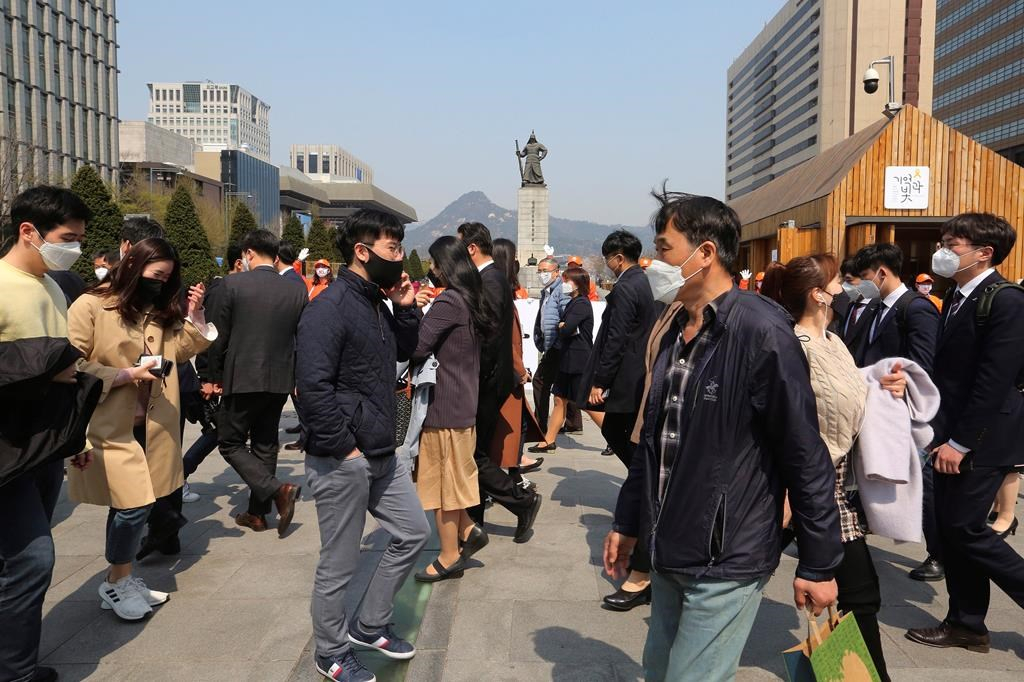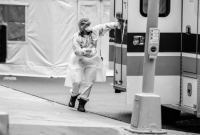Support strong Canadian climate journalism for 2025
Increasingly frustrated health officials say they are prepared to take more aggressive measures to track and contain people with COVID-19 as the number of sick and dead continues to soar.
And that could involve employing some of the digital and mobile strategies seen in countries including Singapore and South Korea where suppression has been more successful, they suggest with caveats.
All of this is under review by various public health bodies, but a York University expert in infectious disease modelling warns that delayed action risks allowing the virus to continue its rapid spread, and force even more intense physical distancing measures.
That may be the painful lesson Canada needs to learn, said Jianhong Wu, an experienced modeller who has led multiple national projects on SARS, pandemic influenza, and immunization evaluation.
"Every country has had to go through this first before they learned how serious it is," said Wu, a distinguished research professor whose work includes analysis of epidemic data in Wuhan, China, where the virus was first detected late last year.
The argument for more stringent contact tracing was laid bare in a directive from Ontario's chief medical officer of health this week. Dr. David Williams instructed the province's public health units to use their authority to isolate COVID-19 cases and anyone with whom those infected people came into close contact.
Williams reiterated that in a press conference, noting the social contacts of those infected must also be traced and contained if we're ever to bring the virus to heel.
"Even if we were able to flatten the curve, the real grunt work of public health really then kicks into gear even more," explained Williams, referring to the famous line graph that depicts the steep rise in cases that would result without interventions.
"(With) all these cases you're going to have to do a lot more contacting, more phone calling, more investigating."
Williams said his office is looking at how to add more staff, volunteers and the use of technology towards this effort.
That work will have to persist through the spring and summer in order to make sure infections don't spark "flare-ups."
"We're looking at quickly how to ramp that up — not only for today, but tomorrow and in the future, because this is going to be very important in the days and weeks going ahead," said Williams.
It's "very much intensive" work, he added, and that's where technology can help. Whether that includes the use of mobile tracking tools to keep tabs on the infected is an open question, and one he's not ready to rule out.
"We have many proposals coming in, and nothing is being rejected outright," said Williams.
Canada's biggest hurdle to tech-assisted tracking is public and political aversion to measures that threaten individual privacy, said Wu, but he argued public safety concerns should trump those worries here.
For now, Ontario Health Minister Christine Elliott has suggested the emphasis continues to be on people power. She said Thursday that she hoped medical students can help carry that load.
Such a strategy is already in use in Alberta, where approximately 300 University of Calgary medical students have bolstered that province's ability to contact the infected and make sure they and their contacts self-isolate.
Dr. Richelle Schindler, a resident physician at the U of C who specializes in public health and preventative medicine, said by email that nursing students may be added to the monumental task, in which trackers chase individuals by phone but can send paramedics to check on those they can't reach.
Albertans who violate isolation orders face a $1,000 fine, but courts have been given increased powers to administer fines of up to $100,000 for a first offence and up to $500,000 for subsequent, more serious violations.
Student trackers must have clinical experience but also get two days of training before hitting the phones. They also get program credit for their time.
While the importance of contact tracing has received less attention than testing in Canada, Wu insisted it is a crucial step to suppressing an epidemic.
He noted that test results provide a snapshot of infections that are days, and even weeks, old. But contact tracing can indicate where the virus is as it jumps from person-to-person.
"The public should know that if you want to go back to normal you have to know who is exposed," said Wu, pointing to regions in Asia where the use of mobile data is credited with allowing schools and busy markets to remain open.
Contact tracing generally involves notifying the infected and their close contacts, but really effective tracing would also notify contacts of those close contacts, said Wu.
That's because by the time you've identified people who have the virus, their close contacts may already be infected and spreading it to others.
"Then you can say that the community is safe — we know who is impacted, or exposed, who is infected, and therefore you can go back to resuming some social activities," Wu said.
Toronto Public Health's associate medical officer of health said Thursday his unit is in the midst of "scaling up" tracing efforts by developing a web-based system that would allow more front-line staff to join the effort from home.
The Coronavirus Rapid Entry Case and Contact Management System would allow trackers to input essential case information that can be shared with the province.
Dr. Michael Finkelstein said Toronto currently has more than 100 staff following up with those who are infected and their contacts, and acknowledged that it becomes increasingly difficult to keep pace as cases grow.
But for now, mobile tracking of citizens is not part of Toronto's strategy.
"TPH is aware that some jurisdictions have used this technology and is investigating its use," said Finkelstein by email.
Wu described a synergistic relationship between three pillars of disease suppression: testing, tracing and social distancing. Where one falters, the others must compensate, he explained.
Even if contact tracing becomes less effective as community spread grows, people still need to know the level of infections and degree of exposure.
"It's never too late so you can never give up," said Wu.
"But I think we are at a stage that we really have to kick in the technologies and you really have to have the participation from the public."
This report by The Canadian Press was first published April 2, 2020.
— With files from Allison Jones





Comments